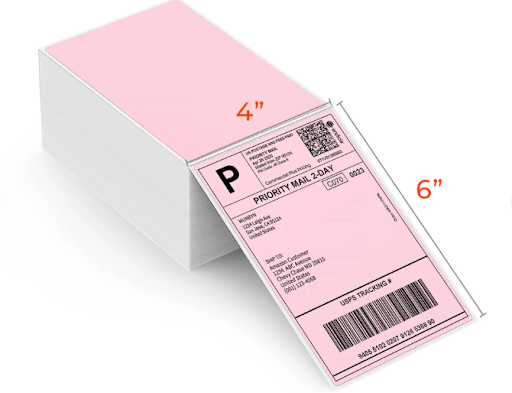Shipping labels play a crucial role in logistics, ensuring that packages are correctly identified, tracked, and delivered on time. Whether you’re running a small e-commerce store or managing large-scale shipments, having the right shipping labels is essential. Among the most commonly used options, 4×6 shipping labels have become the industry standard due to their compatibility with various shipping platforms and printers. Understanding how to choose the right labels and their importance in shipping efficiency can help businesses streamline operations and avoid costly errors.

The Importance of High-Quality Shipping Labels
Shipping labels are more than just stickers on a package—they contain essential information such as addresses, barcodes, tracking numbers, and package details. Poor-quality labels or incorrect label placement can lead to delivery delays, lost packages, and dissatisfied customers. Here’s why investing in reliable shipping labels matters:
1. Accurate Tracking and Delivery
Each shipping label contains a barcode that allows carriers to scan and track the package at every stage of transit. Using high-quality labels ensures that barcodes remain scannable and resistant to smudging or fading, reducing the risk of delivery issues.
2. Compliance with Carrier Requirements
Major carriers, such as USPS, FedEx, and UPS, have specific guidelines for label formats. Many of them prefer 4×6 shipping labels as they provide clear, standardized information that meets scanning and sorting requirements. Choosing the right label size and format ensures compliance with shipping regulations.
3. Cost-Effective and Efficient Shipping
Printing the right labels reduces the likelihood of returned shipments due to address errors or unreadable barcodes. By using durable and well-printed shipping labels, businesses can save money on re-shipping costs and avoid unnecessary delays.
Choosing the Right Shipping Labels
When choosing shipping labels, it’s important to consider several factors, including size, adhesive quality, and compatibility with printers. Here are key considerations to help you choose the best labels for your needs:
1. Label Size Matters
While different carriers and businesses may use a variety of label sizes, the most commonly used format is 4×6 shipping labels. This size offers enough space to display shipping details clearly and is widely accepted by most carriers.
Other label sizes may include:
- 2×7 labels (for smaller packages or envelopes)
- 8.5×11 full-sheet labels (for bulk shipments or international shipping)
- Custom-sized labels for unique packaging needs
2. Adhesive Strength
Labels should have strong adhesives to ensure they remain securely attached to packages throughout the shipping process. Options include:
- Permanent adhesive: Ideal for standard shipping and long-distance transit.
- Removable adhesive: Best for situations where labels may need to be replaced or adjusted.
- Waterproof labels: Suitable for shipments exposed to moisture, such as food delivery or medical supplies.
3. Compatibility with Printers
Not all shipping labels work with every printer type. The two most common printing methods include:
- Thermal Labels: These labels are used with thermal printers, which print by heat rather than ink. They are cost-effective and eliminate the need for ink or toner.
- Inkjet or Laser Labels: These labels are designed for use with standard office printers. They are ideal for businesses that don’t require high-volume shipping but need flexible printing options.
4. Label Format: Rolls vs. Fanfold
Shipping labels come in different formats, including rolls and fanfold stacks.
- Roll Labels: These are wound onto a core and are commonly used in label printers with automatic feed mechanisms.
- Fanfold Labels: These labels are stacked in a zigzag formation and are great for high-volume printing as they take up less space and reduce printer downtime.
Benefits of Using 4×6 Shipping Labels
As e-commerce and logistics continue to grow, 4×6 shipping labels have become the go-to choice for many businesses. Here’s why they are so widely used:
1. Universally Accepted by Carriers
Most major shipping carriers require or prefer 4×6 shipping labels, making them a reliable option for businesses that work with multiple shipping services.
2. Easy to Read and Scan
The 4×6 format provides ample space for important details, ensuring that shipping information is printed clearly and barcodes are easy to scan.
3. Compatible with Popular Shipping Platforms
Online platforms such as Shopify, eBay, and Amazon integrate seamlessly with 4×6 shipping labels, allowing businesses to print labels directly from their order management systems.
4. Reduced Printing Costs
Using 4×6 thermal labels eliminates the need for ink and toner, saving businesses money on printing supplies while maintaining high-quality prints.
How to Ensure Your Shipping Labels Are Effective
To make sure your shipping process runs smoothly, follow these best practices:
1. Use High-Quality Label Stock
Invest in durable labels that are resistant to smudging, tearing, and fading. This ensures that package details remain legible throughout transit.
2. Verify Label Information Before Printing
Always double-check shipping addresses and package details to prevent misdeliveries and customer complaints.
3. Position Labels Correctly on Packages
Labels should be placed on flat, visible surfaces of the package to ensure easy scanning by shipping carriers.
4. Store Labels Properly
Keep shipping labels in a dry, cool environment to prevent adhesive degradation and ensure print quality remains sharp.
Conclusion
Choosing the right shipping labels is an essential step in optimizing logistics operations. Whether you’re looking for general shipping labels or the industry-standard 4×6 shipping labels, understanding the different types, adhesive strengths, and printing options can help ensure efficient and error-free deliveries. By investing in high-quality labels, businesses can improve shipping accuracy, reduce costs, and enhance customer satisfaction.
